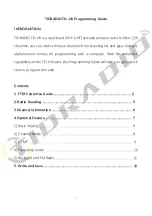
OPTIMIZING SHORTWAVE RECEPTION
Shortwave enables listening to broadcasts over vast distances
including other countries and continents. The following information
will help you get the best results.
• During the day, frequencies above 13 MHz are usually best.
• At night, frequencies below 13 MHz are usually best.
• Around sunset and sunrise, the entire shortwave range may be
good.
• Getting very close to a window and holding the radio improves
shortwave reception.
SSB enables listening to shortwave two way communications
using the single-sideband mode such as amateur radio, Morse
code, weather-fax transmissions and other signals often referred
to as ‘utility’ signals. The Internet and your local library are great
resources to learn more.
Turn on the G5. To use SSB, turn on the SSB circuit by pressing the
SSB button. Note that SSB appears in the display. Tune to the short-
wave frequency of your choice. Use the tuning knob to coarse-tune
the SSB signal, then fine-tune with the –FINE+ knob. This SSB circuit
allows tuning of both upper and lower sideband signals. For best
SSB signal clarity, placing the DX/LOCAL switch in the LOCAL posi-
tion may be desirable.
The DX/LOCAL switch on the left side of the G5 adjusts sensitivity.
Use DX as the default setting for maximum sensitivity to signals. If
TUNING SSB (Single Side Band)
USING THE DX/LOCAL SWITCH
6
G5
OWNER’S MANUAL








































